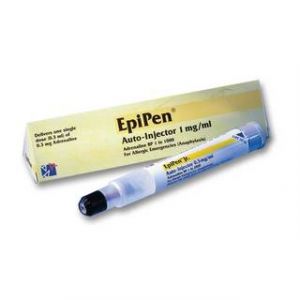Anaphylaxis is the medical name for a very serious allergic reaction. For most people with allergies, they might notice watery eyes, an itchy nose or even a rash when they come into contact with an allergen, but for people that suffer with anaphylaxis, an allergic reaction can be life-threatening.
An anaphylactic reaction can be an incredibly scary thing to experience, and those that are diagnosed with it usually have to carry an adrenaline injection pen with them at all times in order to treat the symptoms of anaphylaxis if they come into contact with a trigger.
If you’ve been diagnosed with anaphylaxis and are sensitive to a reaction, you can buy your extra adrenaline auto injectors from Doctor4U. We offer all three of the UK’s main injections for anaphylactic shock – Epipen, Emerade and Jext.
Anaphylactic reaction
An anaphylactic reaction happens when the immune system overreacts to an allergen and causes an overproduction of histamine. Whilst histamine is produced during a normal allergic reaction, the amount is much higher during anaphylaxis, and can be fatal if it isn’t treated quickly with an adrenaline shot.
Anaphylaxis is usually quick to develop after you’ve been exposed to a trigger, and symptoms and worsen rapidly. However, some people experience mild symptoms at first that go away, followed by a return of the symptoms, increasing in severity. This type of anaphylactic reaction is bi-phasic, but most people that suffer from this type of allergic reaction experience uniphasic anaphylaxis, where symptoms are quick to develop and worsen, but ease with treatment.
In less common cases, some people can be hospitalised for several days with anaphylaxis, needing constant monitoring and care, though a majority of people are able to leave hospital within a few hours after experiencing an anaphylactic reaction.
You may be more likely to experience anaphylaxis if you already have allergies or asthma. Even if you’ve never experienced it personally, having a family history of anaphylaxis can also raise the risk for yourself.
Anaphylaxis symptoms
The symptoms of anaphylaxis are usually fairly easy to spot, especially as they tend to develop very quickly. You’ll be able to tell that it isn’t a regular allergic reaction due to the severity and characteristics of the symptoms. For example, some of the tell-tale signs of anaphylaxis include;
- Feeling faint or lightheaded
- Difficulty breathing, such as fast or shallow breaths
- Wheezing
- A fast heart beat
- Clammy skin
- Confusion
- Anxiety
- Collapse
- Loss of consciousness
Most of the time, you should be able to recognise an anaphylactic reaction before you become unconscious, which is why you should always be aware of the symptoms. This way, you’ll be abl to get help as quickly as possible. It’s also important to tell your friends and family what symptoms to look out for when it comes to anaphylaxis, so they can keep their eye out for you as well.
Along with these signs, you might also experience other symptoms of an allergy at the same time, such as a rash, nausea, swelling and abdominal pain.
Anaphylaxis treatment
The main anaphylaxis treatment across the world is epinephrine – a form of adrenaline that comes in the form of an injection. Everybody that’s had an anaphylactic reaction in the past should be prescribed at least one adrenaline shot, and it should be carried with you at all times in case you’re exposed to a trigger. Your own GP should have shown you how to use your auto injector correctly before prescribing it to you, but if this isn’t the case, you should make an appointment to see your GP or a nurse practitioner so that they can train you on how to use your medication properly.
There are three types of adrenaline auto injector that are available in the UK, and Doctor4U offers all of them. They’re known as Epipen, Emerade and Jext, and all contain the same active ingredient.
It’s a good idea to always carry two auto injectors with you, as in some instances of anaphylaxis, you might need to administer a second injection if your symptoms don’t improve within 10 minutes.
You should always administer your first adrenaline shot at the first sign of anaphylactic reaction to have the best chance of managing your symptoms. However, some people might find it difficult to tell whether they’re having a regular allergic reaction, an asthma attack, or an anaphylactic reaction. In this case, it’s always best to administer the adrenaline, just in case. It’s also a good idea to show your friends and family how to administer the adrenaline shot in the event that you aren’t able to – you can even buy a training device for each brand for this exact purpose.
After you’ve had your shot of adrenaline, you’ll still need to ring 999 and explain your situation so that an ambulance can be dispatched. Whilst you wait for the ambulance, you should lie flat on your back if you can, with your legs raised. If your symptoms don’t improve within 5-15 minutes after you injected yourself with the first adrenaline shot, you should take another.
When the ambulance arrives, you’ll usually be taken to the nearest hospital so that your condition can be monitored, though if the doctors are happy that your symptoms are under control and aren’t returning, you should be able to be discharged within a few hours.
Common triggers for anaphylaxis
There are many different things that can trigger an anaphylactic reaction, though some are much more common than others. Some of the most common include:
- Food allergens such as nuts, fish, shellfish, eggs and even some fruits. If you already have a food allergy, you may be more at risk of experiencing an anaphylactic reaction from some foods.
- Some medicines, most commonly antibiotics and NSAIDs
- Insect stings, particularly from bees, wasps and hornets. However, insect bites can also produce the same reaction in some people.
- General anaesthetic
- Some dyes used in medical tests, for example, the contrast dye that’s commonly used to show up parts of the body in detail during a scan
- Latex
It’s important to know what your triggers are so that you can take steps to avoid them wherever possible. However, some people might not know what causes them to have an anaphylactic reaction. In this case, you might be referred to an allergy clinic in order to try and find out what your body reacts to.
For some people with anaphylaxis, immunotherapy might be an option, for example, those with allergies to insect stings or bites. It might be worth asking your doctor if this is something that would benefit you in the long-term.
Adrenaline in anaphylaxis
Adrenaline is used as a treatment for anaphylaxis due to its ability to relieve the symptoms rapidly. Adrenaline is fast-acting, especially when injected into the muscle, and within a few minutes it should work within your body to open up the airways, helping you to breathe more easily.
In addition to this, epinephrine injections can also reverse any swelling, and even help to raise your blood pressure, as this commonly drops when you’re experiencing an anaphylactic reaction.
Adrenaline is the best treatment that you can use for anaphylaxis before medical help arrives, and works much quicker and more effectively than any traditional antihistamine.
Auto injector
Auto injector pens are pre-loaded with epinephrine, and generally have a spring loaded syringe to help you with rapid administration when you need it.
Each auto-injector pen contains one dose of epinephrine for emergency dosing, so you don’t have to worry about whether you’ve had too much or too little, and there’s no need to waste time finding the correct dosage or filling the pen when you’re experiencing a life-threatening allergic reaction.
Auto injector pens are easy to use, and are designed to be simple enough for someone to administer the dose if you’re unconscious, though it’s still recommended to be trained on how to use the device correctly and safely by a GP or nurse practitioner.
Auto injector pens don’t need to be stored in a fridge, so they’re handy to keep in your bag or pocket so you have it with you on-the-go.
Buy auto injector
You can buy epinephrine (adrenaline) auto injectors from Doctor4U safely and easily. We offer all three of the main brains in the UK, and all pens cost around £49.
Please don’t buy adrenaline auto injectors online if you need it for an anaphylactic reaction that’s happening now. You should always have a spare adrenaline shot with you at all times.
Buying an adrenaline shot from Doctor4U can help you to have peace of mind when you need it, as you can order surplus pens from us to have with you in case of anaphylaxis.
















